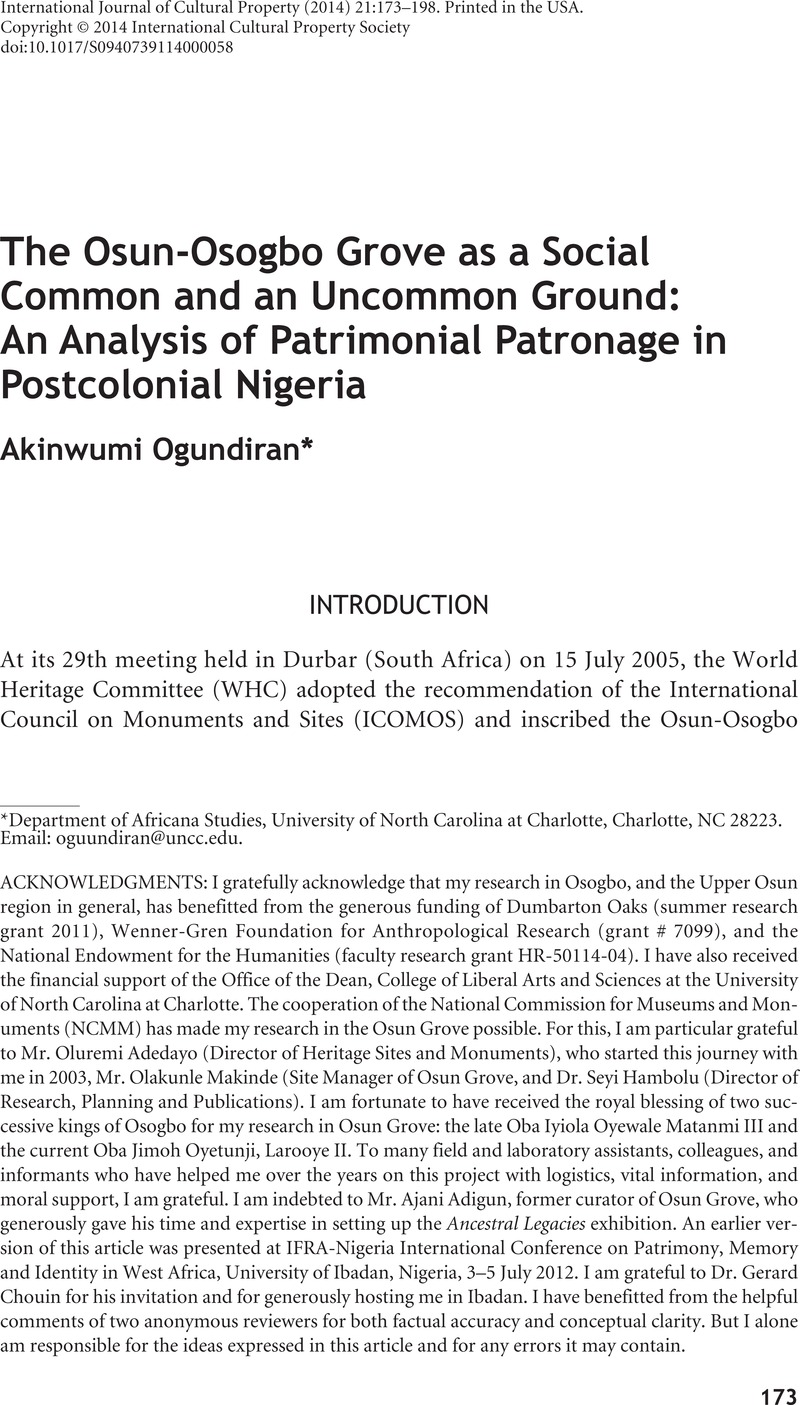Crossref Citations
This article has been cited by the following publications. This list is generated based on data provided by Crossref.
Ogundiran, Akinwumi
and
Ogunfolakan, Adisa
2017.
Colonial Modernity, Rituals and Feasting in Odùduwà Grove, Ilé-Ifẹ̀ (Nigeria).
Journal of African Archaeology,
Vol. 15,
Issue. 1,
p.
77.
Adedeji, Joseph Adeniran
and
Fadamiro, Joseph Akinlabi
2018.
Urbanisation forces on the landscapes and the changing value-systems of Osun Sacred Grove UNESCO Site, Osogbo, Nigeria.
Landscape Research,
Vol. 43,
Issue. 6,
p.
798.
2018.
The Osun-Osogbo Grove as a Social Common and an Uncommon Ground: An Analysis of Patrimonial Patronage in Postcolonial Nigeria—ERRATUM.
International Journal of Cultural Property,
Vol. 25,
Issue. 3,
p.
405.
Chirikure, Shadreck
Ndoro, Webber
Bugarin, Flordeliz T.
di Lernia, Savino
Ichumbaki, Elgidius B.
and
Lwoga, Noel B.
2021.
Usable Pasts Forum: UNESCO and Heritage Tourism in Africa.
African Archaeological Review,
Vol. 38,
Issue. 3,
p.
513.
Adeyanju, Samuel Oluwanisola
Bulkan, Janette
Onyekwelu, Jonathan C.
Peterson St-Laurent, Guillaume
Kozak, Robert
Sunderland, Terry
and
Stimm, Bernd
2022.
Drivers of Biodiversity Conservation in Sacred Groves: A Comparative Study of Three Sacred Groves in Southwest Nigeria.
International Journal of the Commons,
Vol. 16,
Issue. 1,
p.
94.
JA, Ugbe
and
ED, Kuje
2022.
An appraisal of tree and fauna species diversity and distribution of Osogbo sacred grove, Osun State, Nigeria.
Forestry Research and Engineering: International Journal,
Vol. 5,
Issue. 1,
p.
44.
Rauf, Mumini O.
and
Fahm, AbdulGafar Olawale
2022.
Faith Interactions in Osogbo, Nigeria: A Muslim Perspective.
Millah: Journal of Religious Studies,
p.
523.
Ogundiran, Akin
2023.
Storytelling in Archaeology and the Quest for a Pedagogy of Renewal.
African Archaeological Review,
Vol. 40,
Issue. 3,
p.
447.
D. O., Alabi
E. O., Tukasi
O. J., Olufemi
I. O., Ayegunle
J. A., Omotayo
and
C. T., Tunase
2024.
Eco-Theological Implications of Psalms 8 in The Context of Biodiversity Preservation and Field Hunting in Osun Groove.
African Journal of Culture, History, Religion and Traditions,
Vol. 7,
Issue. 2,
p.
34.
Kleinhempel, Ullrich R
and
Nicolaides, Prof Angelo
2024.
Sacred sites, identity, and resilience - on the retrieval of collective and historic identity across religious and cultural difference.
Pharos Journal of Theology,
Oyeleye, Oyewale
and
Bigon, Liora
2025.
Urbanization and Environmental Sustainability: Planning Diagnosis of Symbiosis Between Osogbo City and UNESCO World Heritage Site in Osun State, Nigeria.
Land,
Vol. 14,
Issue. 4,
p.
707.



